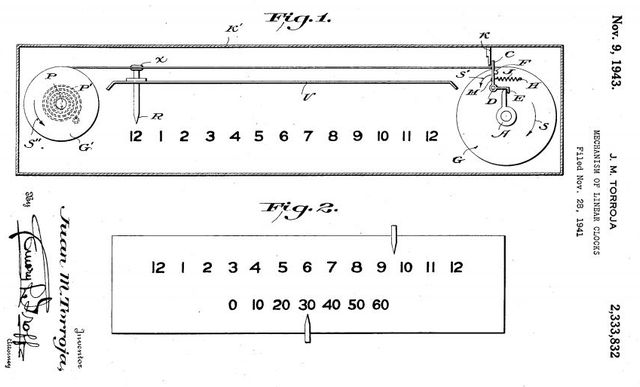Monday, May 25, 2020
More midnight oil
Continuing to ramble about linear clocks.
Repeating from previous:
Would we think of time differently if we were accustomed to linear clocks? Would we value the rest of each day more, and use it more efficiently or enjoyably, if we could see and anticipate the consumption as we do on the Ridhwan and the scribal? I've found that modeling and animating these devices tends to steer my thinking in that direction. Constant exposure to the real thing should do even better.
= = = = =
Google finds only one effort to reinvent the linear clock, in 1943. Patent 2333832 by Juan Torroja of Madrid. Not much detail, not a serious invention. Torroja may have been thinking primarily of billboard-type displays on buildings. His hours over minutes display repeats Ridhwan.


...Whereas here the hands travel, with uniform or variable movement, along a line that may be straight, curved, broken or of mixed nature, keeping or not throughout their course a direction parallel to their initial direction. At the end of the above-mentioned periods of time the hands return automatically to their starting point to travel again over the same stretch.Torroja basically inverts Gabry's mechanism. Gabry used a wrapped pulley or windlass to convert the linear consumption of fuel into rotary motion of the dial. Torroja intended his dial to be tacked onto an existing rotary clock movement, so he used a windlass to convert rotary to linear. It's strange that we haven't retried linear clocks since 1600. Other common indicators have been tried in both linear and rotary forms. Car speedometers, radio frequency dials, slide rules, traffic signals. There's no obvious correlation between the natural form of the measurement and our preferred form. With clocks, the measurement is circular and we prefer circular form. With speed, the measurement is linear and we prefer circular form. With radio freq, the measurement is linear and we prefer linear form. With slide rules, the log pattern is circular and we prefer linear form. With traffic signals, the green/yellow/red pattern is circular, and we prefer linear form... EXCEPT that circular clock-style traffic lights were common for a long time in ... Madrid.
Labels: Equipoise, metametrology, Metrology
